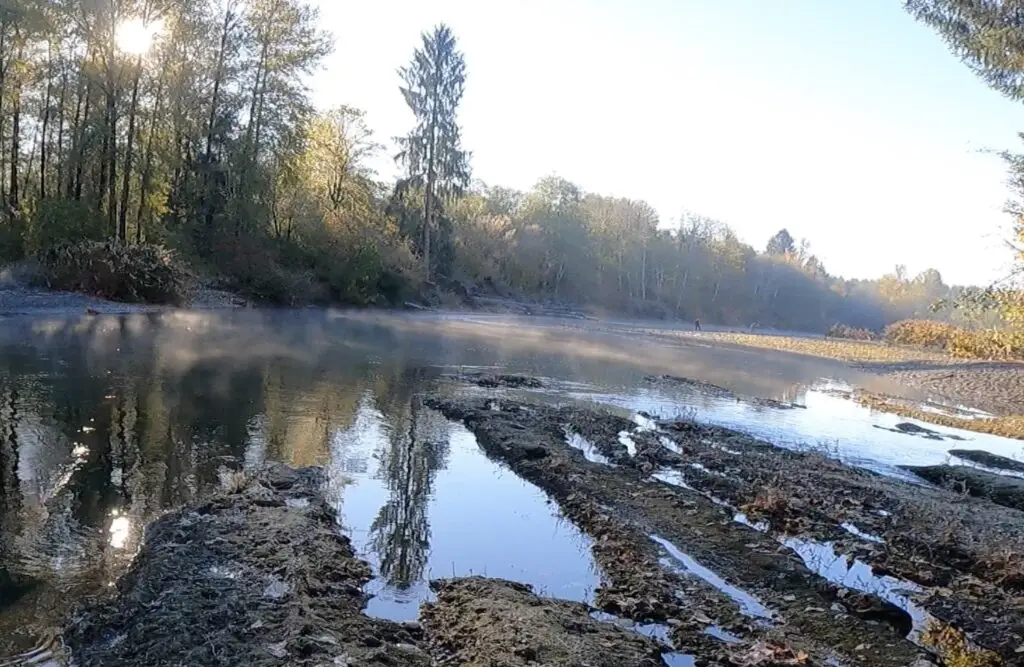
The Humptulips River is the crown jewel of the Washington Coast salmon fishery. Accessible, distant, but not too distant, you will encounter many many fellow anglers on the Humptulips River this fall.
Another plus that draws avid salmon anglers from all over are the numbers and size of chinook and coho. It’s not uncommon to find chinook in that 20-30 lb range, and maybe even bigger. Coho can reach mid to upper teens in size as well.
One of the best ways to fish the Humptulips is in a drift boat. Whether with a buddy who has a boat or with one of the many guides you can hire, fishing your way down the Humptulips always makes for an absolutely epic adventure.
There are many bank fishing opportunities as well as popular access points around the hatchery, Hansen Rd, etc. Other places to access public fishing spots will be near boat launches further down.
The Humptulips River originates on the southwest flanks of the Olympic Mountains and winds its way south, southwest to dump into the north end of Grays Harbor.
There are healthy runs of wild salmon on the Humptulips that spawn in the upper reaches of the system, but also a state run hatchery that raises coho and chinook.
Chum salmon can also return in great numbers to the Humptulips river system. These salmon can show up in huge numbers and be very aggressive, making it hard to get to other species of salmon on some days.
Humptulips River Salmon Fishing 2025
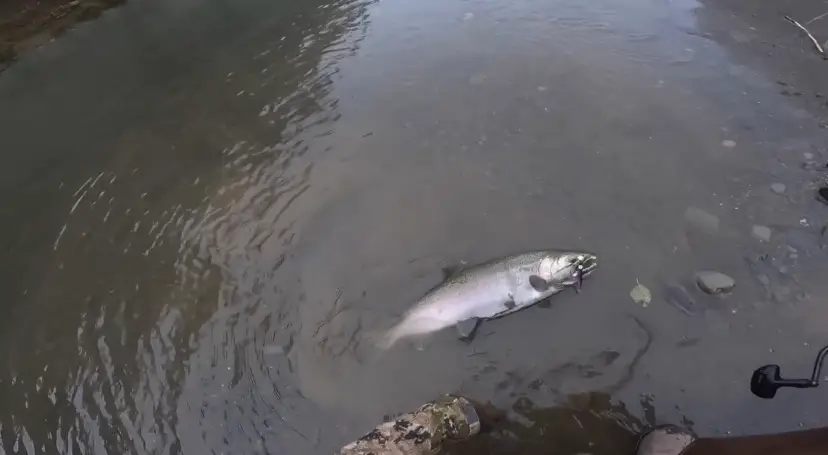
Every year chinook, coho, and chum salmon return to the Humptulips River in good numbers and provide some of the most exhilarating river fishing experiences in Western Washington.
Updated status on hatchery fall chinook returning to the Humptulips River

The above graph will be updated every Thursday typically.
When to fish for Fall Chinook on the Humptulips River?

You will find chinook hanging out in the lower river and in tidewater throughout September, but things really get going when the first rains show up after mid-September and into early October.
As river flows stabilize at a higher flow rate, salmon will spend much less time in the lower river, and they can be found throughout the system, with chinook returning to the hatchery at the highest rate in mid-late October.
To understand how to time the tides, you should check out my article on learning how to river fishing for salmon.
Forecast for 2024 Humptulips River Fall Chinook
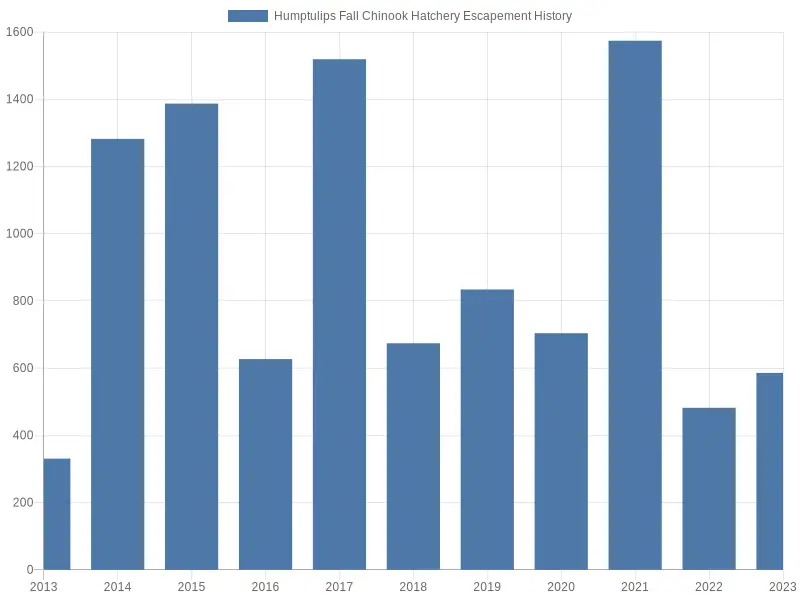
Returns have been sporadic and unpredictable of late, and hatchery returns of adult chinook are forecasted to be even lower in 2024.
Additionally, the natural origin stocks are also on the decline with less expected in 2024 after not meeting escapement goals in 2023.
Updated status on hatchery coho returning to the Humptulips River

The above graph will be updated every Thursday typically.
When to fish for Coho on the Humptulips River?

You can expect to find coho as soon as rain raises the water levels in late September or early October. As with most coho fishing opportunities, water levels often determine the exact timing of the fishery.
Normally you can find coho even throughout December if the river is open to fish for them. The peak coho return to the hatchery is almost always that last week in October to the first week of November.
Forecast for 2024 Humptulips River Coho
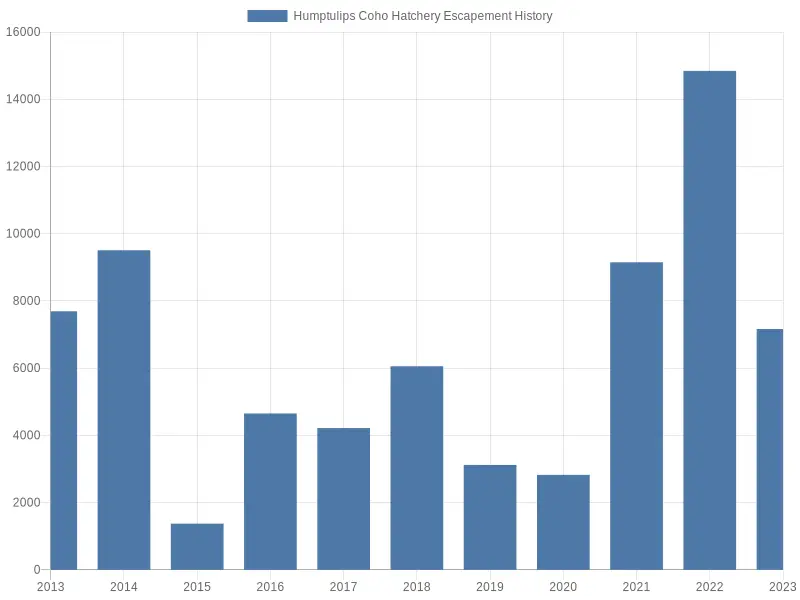
Coho returns on the Humptulips River have been challenging depending on the specific year and 2024 is expected to be another challenging year, especially for natural-origin coho salmon. For hatchery coho, return expectations are also expected to be less than in 2023.
Forecast for 2024 Humptulips River Chum
Chum abundance is expected to be on the upswing in 2024 for the Humptulips River allowing for lots of fishing opportunities and harvest.
How to fish for salmon on the Humptulips River?
The Humptulips River will give you lots of opportunities to use a variety of techniques. Big pools, fast riffles, long runs, and gravel bars allow you to match your favorite technique to the type of water and species you are targeting.
Float fishing eggs is the most popular technique employed in most parts of the river. It’s deadly effective on fresh kings and coho charging up the river when they decide to hold in one of the many perfect drifts for floating eggs.
You can read my page on float fishing for salmon here for tips and specifics.
Of course, my absolute favorite techniques to use on coastal rivers like the Humptulips are twitching jigs and tossing spinners to get that aggressive take that you can feel, that shoots electricity up your arm as a hot salmon tries to rip your rod right out of your hands!
Deeper pools and slower-moving water can be perfect for jigs and spinners, but so can the water you would usually target salmon with float and eggs as well.
Check out my guide to fishing for salmon with spinners and the video above as well.
For twitching jigs take a look at the above video.
Chum salmon are often abundant in the Humptulips and can redeem any fishing trip when the other more sought-after species aren’t around. The above video, some of which was shot on the Humptulips River should help you out.
One of my favorite fishing techniques is fishing for chum salmon with floats and jigs.
Humptulips River Winter Steelhead Fishing 2024-2025
Steelhead fishing on the Humptulips is also quite popular when the wild stocks are healthy enough to permit a hatchery targeted winter steelhead fishery.
The total returns of hatchery steelhead are not typically prolific but certainly enough to capture the interest and attention of local anglers. Targeting below the hatchery after the water rises and begins to drop is likely the best strategy for consistently encountering biting steelhead.
Updated status on hatchery winter steelhead returning to the Humptulips River
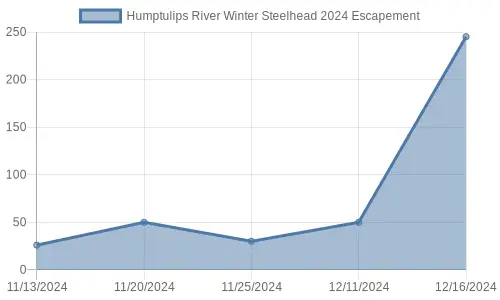
In good years, you will see numbers of hatchery steelhead start to show in November!
When to fish for winter steelhead on the Humptulips River?
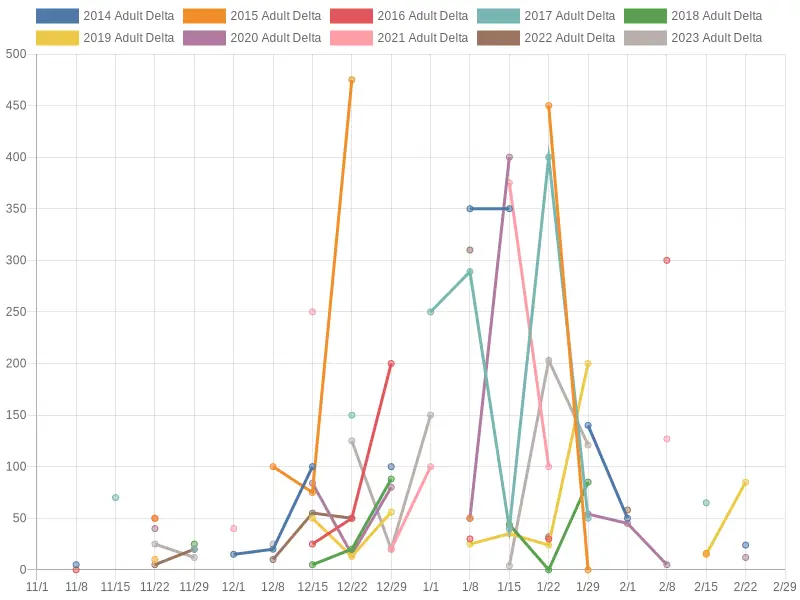
While you can certainly start fishing for hatchery steelhead on the Humptulips River in November, things really get going by about mid-December in most years and continue going strong through about mid-January.
Here’s a link to the Humptulips River gauge on the USGS site for monitoring river flows and planning your fishing trip for Steelhead.
Before you ever go fishing on any river in Washington State make sure you know the regulations determining when a river is open, what part of the river, what gear you can use, and what fish can be retained.
WDFW Permanent Regulations can be found at this link, and we (PNWBestLife) “attempt” to make sure the table at the bottom of this page is also updated with the current permanent regulations.
You also must check the emergency regulations in case there are any changes to the permanent regulations.
Forecast for the 2024-2025 winter steelhead fishing season on the Humptulips River

The smolt plants have been quite consistent for the Humptulips River, which usually means you can expect fairly consistent returns except that ocean conditions are always a little bit different with variations in survival rate.
The 2023 smolts will make up the bulk of the 2024-2025 3 year adult hatchery steelhead return.

In the above graph, 2024 reflects the 2023-2024 return year of hatchery winter steelhead. As you can see, the smolt survival/return rate fluctuates quite a bit, but it has been trending up since the lower survival rate in 2019.
The 2024-2025 return is expected to be better than 2023-2024, so maybe we will get closer to the 1000 level.
How to fish for winter steelhead on the Humptulips River?
I have several important resources on PNWBestLife.com and the YouTube channel to help you become a better winter steelhead angler.
It all starts with reading water. Check out our guide: How to read water for winter steelhead.
Also, check out the YouTube video.
I’ve also got a complete guide to Winter Steelhead Fishing you should check out and again, an accompanying YouTube video below:
Fishing Regulations on the Humptulips River for 2025-2026
| Species | Date | Additional Rules |
from mouth (Jessie Slough) to Hwy. 101 Bridge including all channels, sloughs, and interconnected waterways CRC (358) |
||
All species |
Aug. 16-Nov. 30 |
Night closure. Single-point barbless hooks required. |
Trout |
Sat. before Memorial Day-Mar. 31 |
Statewide min. size/daily limit. Except: cutthroat trout and wild rainbow trout: min. size 14”. |
Other game fish |
Sat. before Memorial Day-Mar. 31 |
Statewide min. size/daily limit. |
Salmon |
Sept. 1-Oct. 24 |
Min. size 12”. Daily limit 6. Up to 1 adult may be retained. Release wild Chinook and wild coho. |
Oct. 25-Dec. 31 |
Min. size 12”. Daily limit 6. Up to 1 adult may be retained. Release Chinook and wild coho. |
|
from Hwy. 101 Bridge to confluence of East and West forks CRC (358) |
||
All species |
Mar. 1-Mar. 31 |
Selective gear rules. |
Aug. 16-Nov. 30 |
Night closure. Single-point barbless hooks required. |
|
Dec. 1-Mar. 31 |
Internal combustion motors prohibited. |
|
Trout |
Mar. 1-Mar. 31 |
Catch-and-release. |
Sat. before Memorial Day-Last Day of Feb. |
Statewide min. size/daily limit. Except: cutthroat trout and wild rainbow trout: min. size 14”. |
|
Steelhead (hatchery) Other game fish |
Sat. before Memorial Day-Mar. 31 |
Statewide min. size/daily limit. |
Mar. 1-Mar. 31 |
Catch-and-release. |
|
Sat. before Memorial Day-Last Day of Feb. |
Statewide min. size/daily limit. |
|
Salmon |
Sept. 1-Oct. 24 |
Min. size 12”. Daily limit 6 including no more than 1 adult. Release wild Chinook and wild coho. |
Oct. 25-Dec. 31 |
Min. size 12”. Daily limit 6. Up to 1 adult may be retained. Release Chinook and wild coho. |
|
Here’s the text of the special rule change as part of the 2024-2025 Washington Coast steelhead season being announced:
Selective gear rules (no bait) and a single-point barbless hook are required this season for coastal steelhead rivers including those in Willapa Bay, Grays Harbor, and along the mid- and northern coasts. The daily bag limit for all rivers and streams is two hatchery steelhead, and anglers must release wild steelhead and rainbow trout. Anglers may not remove wild steelhead fully from the water prior to release.
Additional emergency fishing rule changes could occur throughout the season. Fisheries in April are currently unlikely but are contingent on in-season updates and discussions with co-managers.
The areas listed below are open Dec. 2, 2024 through March 31, 2025 unless noted otherwise.
Humptulips River (Grays Harbor Co.). Upstream of Highway 101 closes Jan. 2. Mouth to Highway 101 closes Feb. 3.
WDFW Washington Coast 2024-2025 Winter Steelhead Season
Please refer to WDFW’s emergency rules page for a full list of rules that are in effect.
It’s your responsibility as the recreational angler to know ALL of these rules, not just what is discussed here on the blog.
Where to fish on the Humptulips River
The main location strategy here is to look for bank access near the public boat ramps: Thorberg, Morley and Hansen Rd / 101 boat launches.
Most people will fish near the hatchery once river flows increase enough to get fish up there efficiently.
This is a river that you should plan to drive out and explore while taking great notes on river flow conditions and what you experience in terms of fishing. This is also a river that I’m not willing to draw maps about, even though many know it quite well.
For those who put the time in, the rewards are potentially great fishing!
Conservation and Habitat concerns on the Humptulips River
You can read about the habitat issues facing the Humptulips River salmon and steelhead populations limiting their abundance on Chehalis Basin Strategy’s website here.
Below is an interesting excerpt I found describing the issues at a high-level.
This ecological region is lacking wood and
stable gravel. River habitat conditions are
influenced by a legacy of logging, including
splash dams that fundamentally altered
instream habitat. In addition, local
extraction of gravel occurred historically.
This has resulted in many reaches that lack
complexity.The lower tidal reach of the Humptulips River
From Chehalisbasinstrategy.com Grays Harbor Tribs Ecological Region Report
is in very good condition, except for invasive
plant infestations. The condition of the delta
of this watershed is an unusual feature; there
has been essentially no agricultural
conversion and little development. The
availability of high-quality habitat could help
magnify benefits associated with habitat
improvements upstream.
Essentially, it’s another case of a river where we don’t have enough beaver activity, log jams, and other types of complexity in upper watershed river conditions that make salmon and steelhead the most productive.
I was also unable to find any comprehensive habitat restoration plan for the Humptulips River. There are a few projects here and there, but nothing significant in the works expected to make a dent in the chronic issues facing the river.